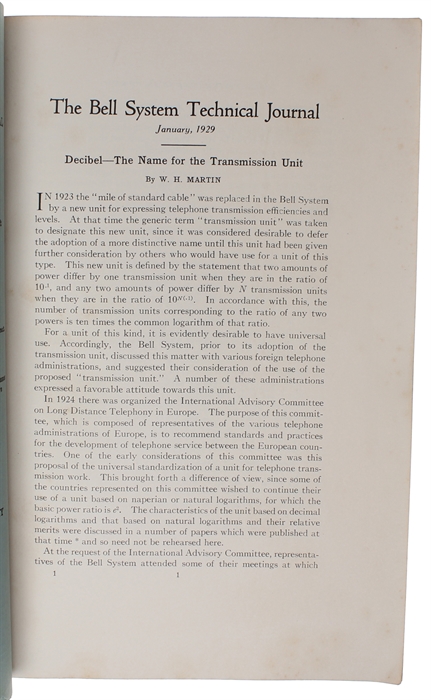COINING THE WORD "DECIBEL"
MARTIN, W. H.
Decibel - The Name for the Transmission Unit.
New York, American Telephone and Telegraph Company, 1929.
Lex8vo. Volume VIII, January, No. 1, 1929 of "The Bell System Technical Journal". In the original printed blue wrappers. Tear to upper part of spine. A bit of minor browning to extremities. Internally fine and clean. Pp. 1-2. [Entire issue: 216 pp.].
First publication of the paper in which the word "Decibel" (dB) was coined and officially announced for the first time. The concept of decibel originates from methods used to measure reductions in audio levels in telephone circuits. Today decibel is being used to measure sound volume in general.
The original unit name decided upon was Bel, in honour of Alexander Graham Bell. Because the Bel unit was larger than needed in practice, one tenth of a bel, the DeciBel, was to become world standard of measuring sound volume.
Up until 1929, The Bell System had used the "transmission unit" (TU) as their measuring standard which was devised to replace the "Miles of Standard Cable ".
In the mid 1920'ies The European International Advisory Committee recommended to the various European telephone administrations that they adopt either the decimal or naperian unit (after John Napier) as a standard for measuring volume.
1 TU was defined as ten times the base-10 logarithm of the ratio of measured power to a reference power level. The definitions were conveniently chosen such that 1 TU approximately equaled 1 MSC. Eventually, international standards bodies adopted the base-10 logarithm as a standard unit, named the bel in honor of the Bell System's founder and telecommunications pioneer Alexander Graham Bell.
Other paper of interest contained in the present issue:
1. Osborne, H.S. The Principles of Electric Circuits Applied to Communication. Pp. 3-20
2. Elmen, G.W. Magnetic Properties of Perminvar. Pp. 21-40.
3. Siegmund, H.O. The Aluminum Electrolytic Condenser. Pp. 41-63.
4. Darrow, Karl K. Contemporary Advances in Physics, XVII, The Scattering of Light with Change of Frequency. Pp. 64-93.
5. Carson, John R. Ground Return Impedance: Underground Wire with Earth Return. Pp. 94-98.
6. Molina, E.C. Application to the Binomial Summation of a Laplacian Method for the Evaluation of Definite Integrals. Pp. 99-108.
7. Mason, W.P. A New Method for Obtaining Transient Solutions of Electrical Networks. Pp. 109-134.
8. Bostwick, L.G.Acoustic Considerations Involved in Steady State Loud Speaker Measurements. Pp. 135-158.
9. Frederick, Halsey A. Recent Advances in Wax Recording. Pp. 159-172.
10. MacKenzie, Donald. Sound Recording with the Light Valve. Pp. 173-183.
11. Stoller, H.M. Synchronization and Speed Control of Synchronized Sound Pictures. Pp. 184-195.
12. Scriven, E.O. A Sound Projector System for Use in Motion Picture Theaters. Pp. 196-208.
Order-nr.: 43386


